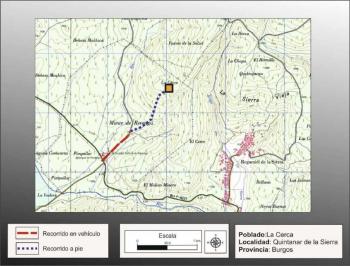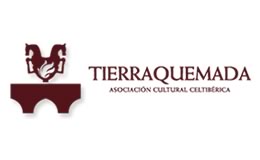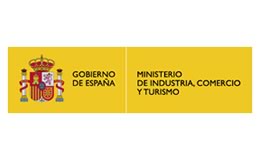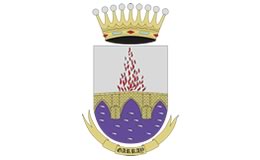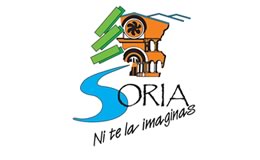The name of the city
Clunia name is of Celtic origin, as shown in the legend of the coin reads Kolounioku.
References celtiberica Clunia
The classic texts:
Roman texts refer to Clunia in later times and usually for reasons of war. We know from Pliny (Sallust and Plutarch) of his belonging to the Celtiberia, as regards this city as the end of the Celtiberia (Celtiberiae finis ") and Ptolemy places it among the Arevaci. These data indicate vacceos its proximity to the valley of the Duero, which is ratified by Clunia participation in the revolt of these cities (56-55 BC)
Clunia was besieged by Pompey (Wars Sertoriana) in 75 BC, as Sertorius had taken refuge in this city. Yet he had to leave the site because of continuing harassment and harsh winter. But three years later, in 72 BC, after the death of Sertorius, would be finally taken by Pompey, as have Exuperancio and Floro.
In 56 a. C., according to Dio Cassius, Clunia joined the uprising of the cities Vacca, which released the fence that had been submitted Q. Metellus Nepos, but next year the revolt was suppressed by Afranio legacy of Pompey.
Numismatics:
The city minted coins in Sertorian period (1980-1972 BC), denarii (silver coin) of type celtiberica (male head with dolphin and rider spear, on the back), with the legend of the city Kolounioku. Also in mid-century I a. C. emits a series of bronze (Ace) with Latin legend, but keeping the type celtiberica.
Where lies the Clunia celtiberica
Location other than the Roman
The ancient texts make no reference to its location, but their group Arevacos (Ptolemy) and its location on the edge of the Celtiberia (Pliny) and its proximity or relationship with vacceos, in the revolt of these cities (56 - 55 BC).
The possibility of a different location in the city and the Roman celtiberica was raised at the beginning of last century, by Ignacio Calvo (1916) who reviewed various fields of environment, including the Alto Horn would not resolve the issue. But later researchers as Saturio Gonzalez and, above all, Osama (1964) refers to the existence in this field with the remains of a fort wall and Iberian and Roman ceramics.
However, Taracena, who conducted important excavations in the Roman city, thought that the Indian city was in the same place as the Roman (1931-34). Later, P. of Palol with different teams since 1956 was that more time devoted to the Roman city, he assumed that the Indian should be placed Clunia Alto Horn, since the excavations of the Roman city remains were not before Tiberius, the has been assumed by subsequent research.
Situation and location
Clunia before the arrival of the Romans, would be an important city of the tribe celtiberica of Arevaci, located on the neighboring hill of El Alto Horn, facing the Alto del Castro, site of the Roman city, the other Arandilla river side. Both sites belong to the end of Peñalba de Castro.
The settlement would be divided into a series of platforms above the moorland, at the confluence of Arandilla and the Mirror, which is known as the set of The Castrillo (High the psalter, Redondo and the Horn) and its highest elevation reaches a height of 1.021my about 120m above the valley of the river Arandilla, Alto Horn being the highest and the core.
El Alto Horn, with an important work of terracing the hillside, was inhabited in the top half, while its upper platform defended by a wall, which is attached dwellings, stone and adobe structure with stone mills , iron slag and abundant pottery.
Chronology
There is no referenciapara the beginning and end of the occupation of the Horn Alto, but the abundance of ceramic celtiberica full stage, it appears that the peak corresponds to the third century BC and would be destroyed and abandoned after Sertoriana Wars.
ROMAN CLUNI
Getting there
It is accessible from the N-1, Madrid-Burgos, and from the N-122 Valladolid-Zaragoza, to reach Aranda de Duero, from here take the CL-111 address and Clunia Peñaranda de Duero, passing the village of Coruña del Conde comes a shift to the left leading to Peñalba de Castro and the Roman city. Another possible access is diverted from the N-234, Soria-Burgos, after the town of La Gallega, take the CL-111, direction to enter Peñalba Aranda de Castro and access to the site.
Situation and location
The Roman city is located, near the village of Peñalba de Castro, on the broad hill (about 130Ha extension) known as Alto del Castro (1023 m asl), which dominates the surrounding area.
Research
The knowledge of the archaeological remains of the Roman city known from ancient times, being cited and reproduced in different stories and writings from the sixteenth century, it is well documented that his remains have served as a quarry since the Middle Ages to the construction of environment and especially from 1788, when John Loperraez, in his History of the Bishop of Osma, provides a map of the ruins where you can still appreciate the layout of the urban, with walls and columns, as well as remains of walls, now missing .
First excavations with scientific criteria did not occur until the twentieth century, first under the direction of Ignacio Calvo (1915-1916), but will be especially Taracena Blas, when work began to take shape, dug between 1931 and 1934, a big house, now known by the name of its discoverer. The Civil War and the death of Taracena, in 1951, conditioned that the work could not be restarted until 1956 by Pedro de Palol, who spent much of his life with different research teams in this city, leaving followers.
Since 1995, a team led by archaeologist F. Tuset and architect M. A. of the Church, are carrying out important work study and appreciation of this important Roman site in the context of the City Master Plan, promoted by the Junta de Castilla y Leon and the Council of Burgos. The architect
The name and foundation of the Roman city
After the Wars Sertoriana and their participation in the revolt with the cities vacca (56-55 BC), at the beginning of the Roman Empire the population of this area would be regrouped in the city of Rome is now known in the Alto del Castro.
It is possible that the very site of the city and its role in these wars lead to Rome to maintain a fixed in place, thus creating the Clunia Roman, who will inherit the old name, reflecting the Indian trail to the entries in Iberian characters Advanced Writing in the currencies that keep the above types and the name of the city, although the Latin alphabet
Not known for certain when the founding of the Roman city, however the oldest remains under a Julio-Claudian era, as in the excavations of the city was a deep layer in a house, from time of Tiberius with Spanish-Roman coinage bearing witness to the title of municipium CLVNIA and the resumption of the coinage at this time.
The city focused the attention of the empire to proclaim it the general emperor Sulpicio Galba (68 AD), faced with Nero. Here Galba received the news of the death of the former emperor and his appointment as emperor. It is likely, although there is no time finding until later that the title of Colonia Clunia Sulpicia was granted by the Emperor, giving his name.
It was the capital of Coventus Cluniensis, one of seven legal convents of the province Hispania Citerior Tarraconensis, located on the road that went from Caesaraugusta (Zaragoza) to Asturica Augusta (Astorga). Clunia home is a place name Arevacos.
Bibliography
- Palol, P. of (1994). Clunia. City history and guide to the excavations. Diputacion Provincial de Burgos. Junta de Castilla y Leon. Burgos.
- Palol, P. de; Guitart, J. (2000). The large public assemblies: Clunia colonial forum. Diputacion Provincial de Burgos.
- Sacristan, J.D. (2005): Clunia: the ends of the Celtiberia. In A. Jimeno (ed.): Celtiberos: in the wake of Numancia. Salamamca.
- Tuset, F. and De la Iglesia, M.a. "Clunia, territorial center of power. " Cultural heritage and land in the Douro Valley: Proceedings (in press), Junta de Castilla y Leon.
Contacts and schedules
- Guided tours (by reservation): 947 391 250
Hours:
- From April 1 to September 30, open Tuesday to Sunday from 11.00 to 14.00h and from 16.00h to 20.00h.
Price:
- Free visit: 4 € single, 2 € groups over 10 people (students / pensioners).
- Guided tour (arrange in advance): € 5 individual, 3 € (groups / students / pensioners).


